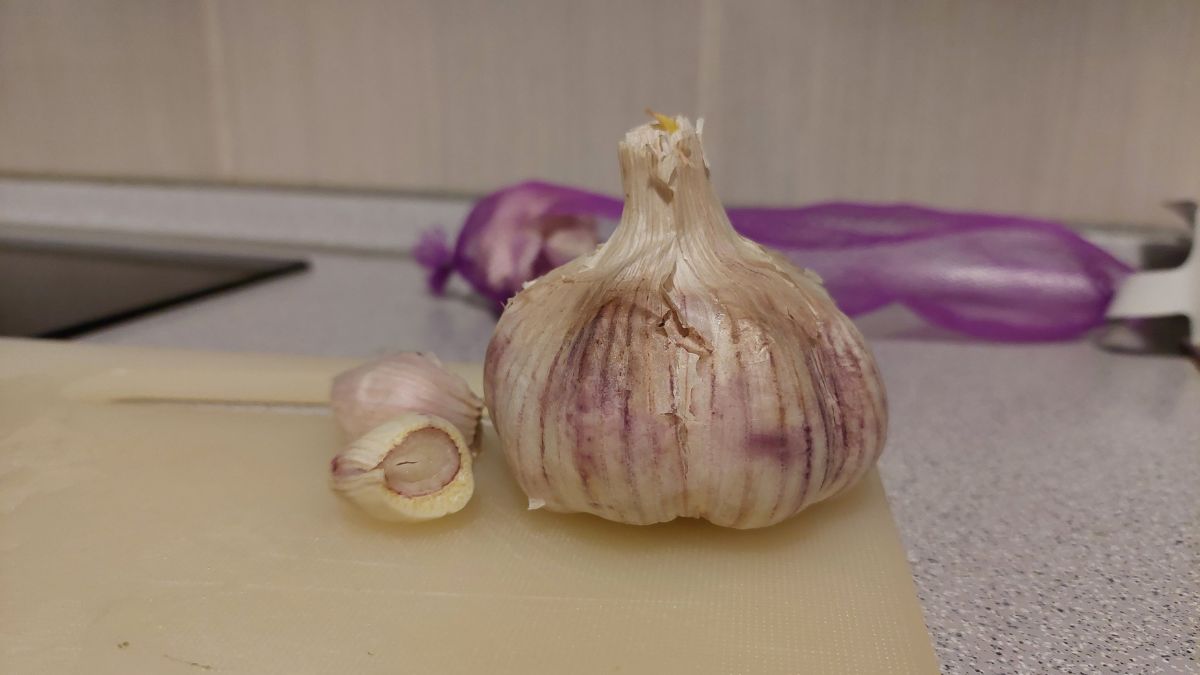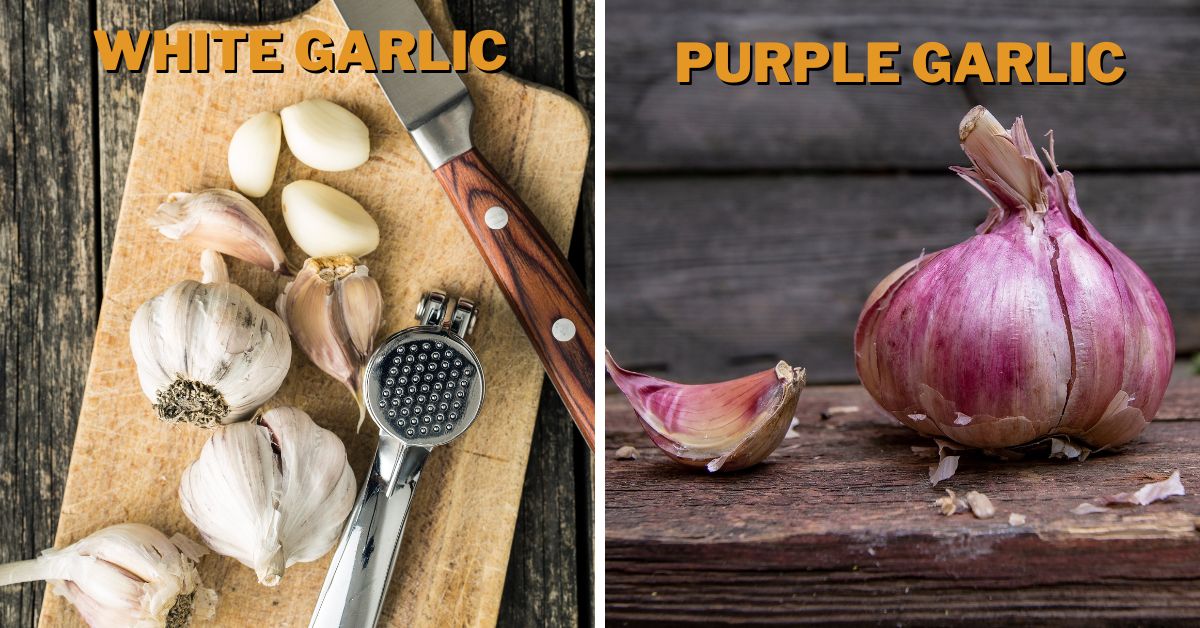Garlic Turning Purple: Why Does It Happen & Can You Still Eat It?

A clove of garlic is a vegetable that can give a fantastic flavor to any savory dish but can also overwhelm it if you go a tad too far. Garlic can also be hard on the stomach, especially for those who have sensitive digestive tracts, because it causes a strong reaction with the stomach acids and acids in general. It can also change its color, depending on the acidity of its environment. So why does garlic turn purple?
Garlic turns purple due to its reaction with acidic substances or metal. When the allicin produced in the garlic reacts with the amino acids from the acidic environment created by the used acid or metal, it produces pyrroles that change the garlic’s color. There is also naturally purple garlic.
Since you are probably used to seeing your garlic white, as it takes a substantial quality of pyrrole to form for it to turn purple, chances are you’ll think that something is wrong with it. Since throwing away such a nature’s treasure, as the garlic truly is, you need to have the right information to know whether to use or throw away your purple garlic. Therefore, in the following paragraphs, I will explain why garlic turns purple, whether it is safe to eat, how to recognize if it has gone bad, and if purple garlic is better than white.
Why Does Garlic Turn Purple?
When you cut, crush, bend or grate, the main component released in garlic is allicin. Allicin is what gives garlic that pungent garlicky smell and taste and makes it so recognizable and flavorful. The allicin makes the garlic so flavorful; that’s why garlic starts to smell the strongest once cut or cooked while having a discrete smell when whole.
This garlic component, allicin, is released when the garlic comes into contact with an acidic environment (lemon juice or vinegar) or metal such as iron, steel, or copper. So if your utensils are made of those materials, and you plan on acidifying your garlic, expect some purple to appear.
The allicin component reacts with the amino acids and creates pyrroles, which turn the garlic purple. The intensity of the newly-created purple color is variable and is very dependent on the number of pyrroles created in the garlic.
Sometimes the purple color can be hardly noticeable and only on the rims of the garlic, but sometimes it can be really strong. The amount of pyrroles depends on the amount of allicin released in the garlic, and the amount of allicin depends on the external stimulus given to the garlic.
In other words, the more you physically work on the garlic, meaning the longer it is in contact with the knife or grater, the more purple it will get. Also, the more acid you use, the more allicin you will get. That’s the reason why the sourer the garlic, the more pungent its smell, it’s the allicin release.
Is Garlic Still Good When It Turns Purple?
Much associate purple garlic with spoiled or damaged garlic, while, in fact, that isn’t factual. The chemical reaction created in the garlic due to the allicin release and subsequently the creation of the pyrroles has nothing to do with the quality of the garlic, as it is perfectly safe to eat.
The reaction due to contact with an acidic environment does not affect the garlic in terms of edibility but aesthetics. You may associate the color purple with spoiled food, as some do, but purple garlic does not equal spoiled garlic.
However, there will be changes in the intensity of the flavor because the garlic will acidify, thus becoming even more pungent and intense, with a slight acidic tang that may confuse you even more on whether it is edible or not.
However, no matter the changes in its appearance, taste, and aroma, the garlic will still be perfectly fine to eat and cook with.
How to Tell If Garlic Cloves Have Gone Bad?
It is a real shame when garlic cloves go bad, meaning you need to throw them out, but luckily, they tend to show some explicit signs of spoilage, so you won’t risk eating spoiled food.
Eating spoiled garlic can cause some really hard consequences on your stomach, and moreover, it will also transfer the spoilage to the food you mix it with. So if you put spoiled garlic in a salad and remove it afterward, the salad won’t be salvageable.
If your garlic has gone bad, it will show signs you can see, touch, and smell. I am not mentioning taste here, as you won’t be tasting garlic that looks and smells appalling.
Spoiled garlic has a foul smell, especially when peeled, and if the spoilage has gone far enough, you don’t even have to peel it to smell it.
The color of the garlic will also change. At the initial stages of spoilage, it will seem a bit darker at some spots and discolored on others, but if the spoilage is further along, the color will vary from eggshell to light brown.
The garlic’s texture will also exhibit signs of spoilage, such as sliminess and excessive softness. If the garlic is farther along in the spillage process, you can puncture it with your finger, as it will pop right away showing you its mushy inside.
The smell is too intense, and it resembles that of rotten eggs. If you ever notice some of these signals, do not even try to use your garlic, but throw it away immediately, as it is not worth the risk.
Is Purple Garlic Better Than White?
Many people associate purple garlic with bad garlic, while it is just as good as white garlic. Purple garlic doesn’t have to be white garlic turned purple, as there is a variety of garlic that is naturally purple.

Therefore you can find purple garlic in the grocery stores. The purple garlic has a harder stem, and the cloves don’t grow as close together as those of the white garlic. It is purple on the outside, but on the inside is still white.
White garlic has a more flexible stem and tends to be softer and more receptive to flavors than purple garlic. In any case, both purple and white garlic is very similar in shape, taste, texture, use, and aroma, with that recognizable pungent dimension they share.
Purple garlic also tends to bear bigger cloves than white, but certain varieties of white garlic are just as large.
The three types of purple garlic are purple stripe garlic, striped marble garlic, and glazed purple garlic. It is available in US stores; however, it isn’t produced in the US. For the most part, purple garlic comes from Mexico, Russia, China, Tasmania, Australia, Spain, and Italy.
